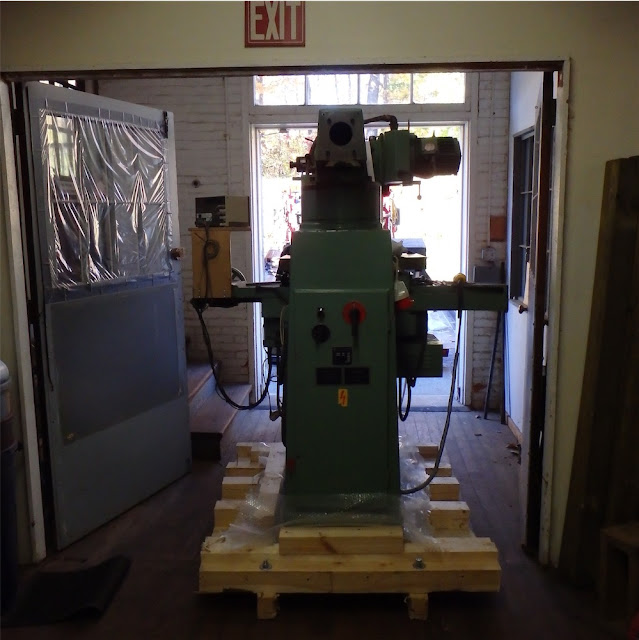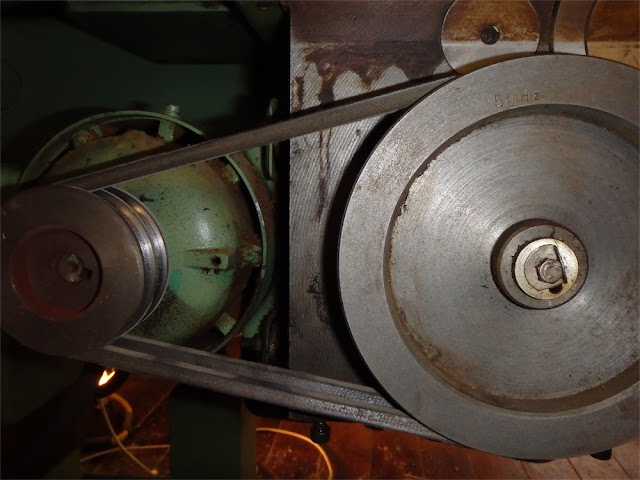Oh yeah, 1981. I was in grade 10, and the Scorpions, a German heavy metal band, were one of my faves:
I remember seeing them live in concert in Vancouver around 1982. Despite their fearsome appearance, I lived to tell the tale. Not that it is a tale I tell especially often….
Anyway, nostalgia aside, I have finally gotten to meet a new German heavy metal friend, by the name of Zimmermann, FZ-5V to be more accurate. After it languished in customs for 10 days, a semi had gone to the Boston customs house to pick it up only to find the crate it came in was too tall to fit inside the trailer. That lead to a 4-day delay, the hiring of another trucking company, extra charges slapped on for storage, and then finally it made its way out to Western Mass. Then it sat at the tow truck/riggers yard for another 12 days as they were simply run off their feet with towing work.
Yesterday, they showed up with ‘the monster’ however:
After backing up into a suitable alignment with the doorway, and pushing the hydraulically-operated 'Jerrdan’ deck of the truck all the way back to the door threshold, it was obvious that the the pallet was not going to fit through the opening:
Out came a sawzall with a very dull blade and the pallet trimming could begin:
While this was going on, I wriggled the secondary milling head off the pallet and onto a dolly:
This looks like such a little milling head when mounted on the machine, but it weighs close to 200 lbs. More than I want to lift by my own muscle power.
After a good 45 minutes of sweating and cursing by the riggers, and an extremely tight squeeze through the doorway, the machine was in the building:
I had been more worried about the height of the machine being a problem through the doorway, but the width of it turned out to be nearly the exact same dimension as the doorway, at 64". If the machine had been turned 90˚ on its base it would have gone through no problem, but the riggers double checked the measurements and were able to just get it through without recourse to spinning the pallet, which would have created other headaches. A sheet metal part on the machine did get a little damaged during the squeeze-though, but it will be easy to straighten out.
With the help of another two guys from the adjacent cabinet shop, the 5 of us pushed the machine down to the back of the shop and close to its eventual resting position:
I (and my landlord) had also been concerned about the building floor getting crushed by a machine twice as heavy as any other in the shop, but the old floor bore the weight no problem, albeit with some loud creaks and squeaks at various spots along the journey. I did take care to locate the machine position directly above a sleeper, in the interest of minimizing floor deflection.
At this point, given that the riggers charge $225/hour, I said “thank you very much!” and sent them on their way. The rigging cost me $800 altogether. I figured I could get the machine off the pallet by myself.
A while later I had used a handsaw to cut the middle portion of the pallet away, which enabled me to tuck the pallet jack in there:
The FZ-5V weighs around 5500lbs, which is in fact the very limit of the pallet jack. I’ve certainly never lifted something this heavy with the jack before. It did the job!
A while later, the rest of the pallet is gone and I’m onto blocks each side:
And then finally I got it onto the floor, with a couple of blocks on the front to level it out (yes, the floor in my building is that far out of level in that location):
I also rotated the milling head into the normal upright position. It was nice to find that the milling head can be moved forward and back, angled up and down, and turned clockwise or counter-clockwise using hand-cranked gear-driven mechanisms. No need to take the weight directly with my body, thank god. I loosened the central pivot (4 bolts), and found that the entire upper ram with milling head can be easily swiveled around.
Next Day:
The top beam needed to be swiveled around for the next step, which was mounting the secondary milling head. I rigged up a come-along to an overhead ceiling joist and winched the head up to position:
I have learned to trust bowlines with many tasks and have never been let down.
It took all of 10 minutes to get it into position and bolted up:
With that head bolted into place, the upper ram assembly had certainly become a fairly long affair.
I could now turn my attention to the other matters. After trying unsuccessfully to tighten the spindle locknut, I finally realized it needed to turn the opposite way and off it came (the doh! moment of the day):
The local machine shop guy came by to take a look at the German invader, and he was also thinking the collet nut went the other way to come off, so I am glad it wasn’t just me. That collet nut is a big chunk of metal, with ball bearing smoothness built in. I thought the ISO 40 tool holders were fixed by a long 16mm bolt from above, but they are tightened from below by the collet nut just like a (giant) router.
I discovered one issue, and that is that the main spindle’s quill is frozen in terms of z-axis travel. It should be able to work just like a drill press, but the quill assembly seems totally stuck. I suspect the locking mechanism inside is somehow not loosening when it should. I’m thinking I may have to disassemble the head to get to the bottom of it.
The high speed spindle, once power was put to the machine, worked great and I tested it out by mounting the chuck and drilling in some teak, a task I had been waiting to do until the machine was in place:
It made by far the cleanest and straightest hole I have ever produced in all my years around woodworking equipment of all kinds. In my building there are at least 5 drill presses scattered here and there, and not one of them can produce a concentric hole. Why woodworking drill presses are typically so poor, I have no idea.
I was happy to have at least that modest 'drill press’ functionality, with so much more to come, as I gain familiarity with the machine and resolve remaining technical issues.
The DRO works just fine:
I’m hoping that the z-axis can be hooked up to the display and the machine at some point.
A look next at the electrical area, accessed from the rear of the machine through a heavy door. I guess you can tell the manufacturer gives a shit when they have painted the inside of the casting with gloss paint:
Some very old school fuses in there - I refer to those white knobs you see all over the door panel. Nothing too complicated, and no computers or sensors. That simplicity translates into fixability and should ensure a long lifespan for the machine.
The electrical hook up is temporary for the time being as I will need to drill a larger hole in the side of the machine to accept the porky 10-gauge electrical cable. The machine is wired with a neutral, which was a surprise. Hopefully it will run fine without having to provide a neutral on the supply side, which bonds to ground at the transformer in any case.
I had a minor issue with a loose wire as a result of squeezing the machine in through the doorway, but once rectified, everything seemed to work well. Curiously, while the spindles turned the correct direction, the powered z-axis and x-axis controls worked backwards in direction. Not sure at this point exactly why that is, but it will be easy to correct. One of the nice things about 3-phase motors is that they are happy running both forwards and reverse, and can be switched quickly.
I pulled the cover off the x-axis drive motor, and noted that the pulleys were marked '50 Hz’:
The drive pulley seems to have a minor issue with the woodruff key:
I am guessing they marked both pulleys with '50 Hz’ so they went in as a set without confusion, though to make an adjustment for 60 Hz, only one of the pulleys would have to be sized down 20% I would think.
All in all, the machine is massively built and oozes high quality, certainly on a par with Martin. I’m pleased to call it mine. Everything works except for the main spindle’s frozen quill. At least I can use the high speed secondary head in the meantime, though it has a somewhat less convenient z-travel adjustment. I’ve still got some cleaning and inspection to do, and the machine needs oiling and greasing. The electric cables are a bit greasy and tatty and one of the electrical junction boxes could use replacement. The x-axis drive motor belts are also tired.
I’m hampered by having no operation manual or spare parts list, so I am very much fumbling around in the dark at present with some of the functions.
The machine came with what appeared to be a good assortment of tooling, however on closer inspection, there are some important parts missing from several of the tool holders. I’m in the process of identifying what I have and what is missing and will be ordering parts as I figure out my requirements and as I can afford them. I have a couple of collet tool holders, one is the ER 32 size and the other is larger and another type, perhaps 'OZ’. I’m not sure. All the collets I have are metric, so I think it will be a plan to also obtain some inch-scale ones as well. The shell mill tool holder needs a special wrench to mount and demount the cutters, and now that I have figured out its size I can order one from Germany.
Collets also appear in woodworking machines, notably routers, however it is a greatly simplified situation as compared to metal working equipment. There is a dizzying array of different types of tool attachment systems, tool tapers and collet types, and I’m in the early stages of getting my head around all that. It’s been very educational so far.
That’s it for this time - hope you’ll pop back for another visit somewhere down the line. Until then, keep the tools and mind sharp.
via Tumblr http://davidpires578.tumblr.com/post/132300941729


















No comments:
Post a Comment